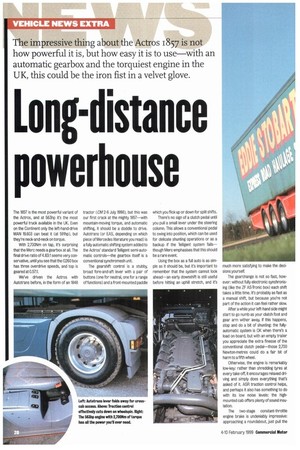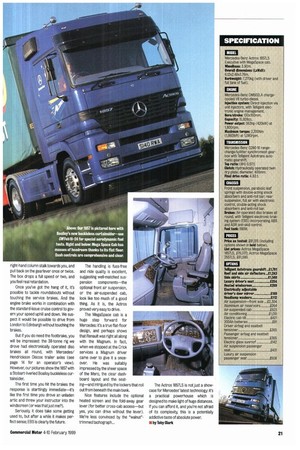to g-distance werhouse
Page 22

Page 23

If you've noticed an error in this article please click here to report it so we can fix it.
The 1857 is the most powerful variant of the Actros, and at 563hp it's the most powerful truck available in the UK. Even on the Continent only the left-hand-drive MAN 19.603 can beat it (at 591hp), but they're neck-and-neck on torque_ With 2,700Nm on tap, it's surprising that the Merc needs a gearbox at all. The final drive ratio of 4.83:1 seems very conservative, until you see that the G260 box has three overdrive speeds, and top is geared at 0.57:1.
We've driven the Actros with Autotrans before, in the form of an 1848
tractor (CM 2-8 July 1998), but this was our first crack at the mighty 1857—with mountain-moving torque, and automatic shifting„ it should be a doddle to drive. Autotrans (or EAS, depending on which piece of Mercedes literature you read) is a fully automatic shifting system added to the Actros' standard Telligent semi-automatic controls—the gearbox itself is a conventional synchromesh unit.
The gearshift control is a stubby, broad fore-and-aft lever with a pair of buttons (one for neutral, one for a range of functions) and a front-mounted paddle which you flick up or down for split shifts.
There's no sign of a clutch pedal until you pull a small lever under the steering column, This allows a conventional pedal to swing into position, which can be used for delicate shunting operations or as a backup if the Telligent system fails— though Merc emphasises that this should be a rare event.
Using the box as a full auto is as simple as it should be, but it's important to remember that the system cannot look ahead—an early downshift is still useful before hitting an uphill stretch, and it's much more satisfying to make the decisions yourself.
The gearchange is not so fast, however: without fully electronic synchronising (like the 7F AS:fronic box) each shift takes a little time. It's probably as fast as a manual shift, but because you're not part of the action it can feel rather slow.
After a while your left-hand side might start to go numb as your clutch foot and gear arm wither away If this happens, stop and do a bit of shunting: the fullyautomatic system is OK when there's a load on board, but with an empty trailer you appreciate the extra finesse of the conventional clutch pedal—those 2,700 Newton-metres could do a fair bit of harm to a fifth wheel.
Otherwise, the engine is remarkably low-key: rather than shredding tires at every take-off, it encourages relaxed driving and simply does everything that's asked of it. ASR traction control helps, and perhaps it also has something to do with its low noise levels: the highmounted cab offers plenty cf sound insulation.
The two-stage constant-throttle engine brake is undeniably impressive: approaching a roundabout, just pull the right-hand column stalk towards you, and pull back on the gearlever once or twice. The box drops a full speed or two, and you feel real retardation.
Once you've got the hang of it, it's possible to tackle roundabouts without touching the service brakes. And the engine brake works in combination with the standard-issue cruise control to govern your speed uphill and down. We suspect it would be possible to drive from London to Edinburgh without touching the brakes.
But if you do need the footbrake, you will be impressed: the 38-tonne rig we drove had electronically operated disc brakes all round, with Mercedes/ Hendrickson Discos trailer axles (see page 14 for an operator's view). However, our pictures show the 1857 with a Stobart-liveried Boalloy buckleless curtainsider.
The first time you hit the brakes the response is startlingly immediate—it's like the first time you drove an unladen artic and threw your instructor into the windscreen (or was that just me?).
Seriously, it does take some getting used to, but after a while it makes perfect sense; EBS is clearly the future.
The handling is fuss-free and ride quality is excellent, suggesting well-matched suspension components—the optional front air suspension, or the air-suspended cab, look like too much of a good thing. As it is, the Actros proved very easy to drive.
The MegaSpace cab is a huge step forward for Mercedes: it's a true flat-floor design, and perhaps shows that Renault was right all along with the Magnum. In fact, when we stopped at the Crick services a Magnum driver came over to give it a onceover. He was suitably impressed by the sheer space of the Merc, the clear dashboard layout and the seating—and intrigued by the lockers that roll out from beneath the main bunk.
Nice features include the optional heated screen and the fold-away gear lever (for better cross-cab access—but yes, you can drive without the lever). We're less convinced by the "walnut"trimmed tachograph... The Actros 1857LS is not just a showcase for Mercedes' latest technology: it's a practical powerhouse which is designed to make light of huge distances. If you can afford it, and you're not afraid of its complexity, this is a potentially addictive taste of absolute power.
• by Toby Clark








































































































